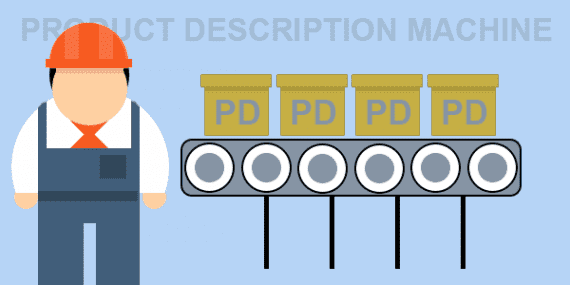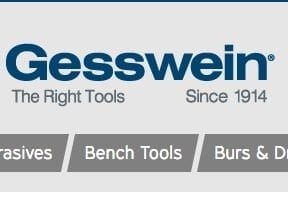
Thinking about writing product descriptions like a mechanical process may help some overcome writer’s block and avoid duplicate content.
Thinking about ecommerce product descriptions like factory-built widgets manufactured to a set of specifications may help ecommerce business owners and managers overcome writer’s block and avoid publishing duplicate content.
Writing product descriptions can be one of the most significant challenges ecommerce businesses face. Some entrepreneurs or managers might not be comfortable with writing. What do you say about a pair of shoes, or a fishing reel, or something like a hammer or a screw?
Poor Product Descriptions Can Harm Your Business
To make matters worse, a poor product description could hurt your ecommerce business. The harm can be done in a couple of ways.
First, a poor, bland product description may not inspire a shopper to buy or give him enough information to make a good buying decision.
Second, if you copy a manufacturer’s product description, your page or even your site may not perform well in search engines. At the time of writing, Google does not penalize sites for duplicate content unless it believes duplication was used to be deceptive. Nonetheless, when faced with duplicate product content across several ecommerce sites, Google may pick just one site to show in its search results.
Create a Product Description Machine
Given the problem of what to write (a form of writer’s block) and the danger of publishing poor product descriptions (lower conversions or duplicate content), some online stores may want to take a mechanical approach to building (writing) product descriptions.
The idea is simple. Rather than sitting down at a keyboard, staring at a picture of your product or trying to rewrite the manufacturer’s description, follow a process.
Step 1: Focus on a Single Thing
Pick one thing about the product. Maybe it is a feature. Maybe is a how you use it. But pick one thing.
For example, imagine that you had to write a product description for a soup spoon. You could feature its relatively large bowl — yes, the working end of a spoon is called a bowl. With this in mind, just write a single sentence describing that bowl. This can be strictly factual.
This soup spoon has a large bowl.
Step 2: Connect to a Benefit
Next, your product-description writing machine should take the single thing, the single fact from step one and connect it to a single benefit to the shopper.
In marketing speak, this is a fact-to-benefit bridge. The fact is that a soup spoon has a relatively large bowl. So compared to spoons with smaller bowls, you get more soup in each bite.
This soup spoon has a large bowl, so you get more soup with each bite.
Step 3: Clarify and Specify
A dictionary tells us that clarification is the act of making a statement less confusing and more comprehensive. Similarly, specification is the act of identifying something precisely.
In the third step of this mechanical process, add words, phrases, or remarks to make the product description more clear.
There is a bit of ambiguity in our current soup spoon description. The bowl is large compared to what? And how large is it? Let’s add a sentence that makes this implied comparison explicit.
This soup spoon has a large bowl. In fact, this soup spoon can hold about three times as much soup as your standard table spoon. So you get more soup with each bite.
In a spoon anatomy class, you would learn that the tip of the spoon is called the bowl tip. The bowl, as mentioned above, is the part of the spoon that holds or carries the food. The drop and the shoulder describe the transition from the bowl to the part of the spoon you hold. And the part you hold might have three sections, too.
But few shoppers understand spoon anatomy, presumably. So while they could probably figure out what our description means by bowl, we can add a bit more clarity.
This soup spoon has a large bowl meant to hold and carry soup to your mouth. In fact, this soup spoon can hold about three times as much soup as your standard table spoon. So you get more soup with each bite.
Step 4: Test Your Words
Read and reread your product description several times. Your first task is to identify and possibly replace words or phrases that are repeated too often.
In my example, the word soup occurs five times in just 42 words. This is not bad given that we’re describing a soup spoon. But if we change even one instance, we would have a bit less word echo.
One way to replace a general word like “soup” is to use specific words. We could name a particular type or types of soup, like “bisques and broths.”
This soup spoon has a large bowl meant to hold and carry bisques and broths to your mouth. In fact, this soup spoon can hold about three times as much soup as your standard table spoon. So you get more soup with each bite.
Using a word variation will also reduce word echo. So try “soupy” instead of “soup.”
This soup spoon has a large bowl meant to hold and carry bisques and broths to your mouth. In fact, this soup spoon can hold about three times as much soupy goodness as your standard table spoon. So you get more soup with each bite.
As you read and reread your product description, your next word-testing challenge is to try to add action words. The soup spoon product description is pretty good. But we might want to replace “hold and carry” with “haul.” This adds a bit of action and also gets rid of another word echo: hold and carry.
This soup spoon has a large bowl meant to haul bisques and broths to your mouth. In fact, this soup spoon can hold about three times as much soupy goodness as your standard table spoon. So you get more soup with each bite.
Step 5: Spell Check and Grammar Check
Applications like Google Docs and Hemingway make it easy to check spelling and grammar. If you use these tools for composition, step five is really a matter of paying attention as you work.
If your product description passes spelling and grammar checks, read it once or twice more, and publish it. Your mechanical product description machine has pumped out a widget, so to speak.
This soup spoon has a large bowl meant to haul bisques and broths to your mouth. In fact, this soup spoon can hold about three times as much soupy goodness as your standard table spoon. So you get more soup with each bite.
Optional: Add an Introduction
You may have a perfectly passable product description. But, you can still add a little polish.
For the soup spoon description, try adding a sentence that sets the tone. Something that may cause the shopper to think about soup.
Hungry for some hearty chicken noodle or creamy clam chowder? This soup spoon has a large bowl meant to haul bisques and broths to your mouth. In fact, this soup spoon can hold about three times as much soupy goodness as your standard table spoon. So you get more soup with each bite.
Optional: Add a Call to Action
If the process is working for you, consider adding a call to action, a sentence or phrase that asks the shopper to buy.
In the soup spoon example, I rewrote the benefit “you get more soup with each bite” to include a call to action.
Hungry for some hearty chicken noodle or creamy clam chowder? This soup spoon has a large bowl meant to haul bisques and broths to your mouth. In fact, this soup spoon can hold about three times as much soupy goodness as your standard table spoon. You could take three times as many bites, or you could buy this soup spoon and slurp large.
About Writing and Using Product Descriptions
Thinking about building product descriptions step by step could make the task of writing them less daunting. But it is just one method. There are others.
Contributing Editor Pamela Hazelton wrote an article in February 2016 offering tips to improve product descriptions. And back in 2011, I wrote an article describing how to write product descriptions that sell.




